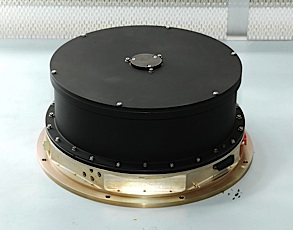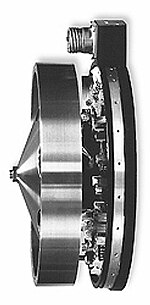In a
Kepler Mission Manager Update, NASA announced today that the Kepler mission is temporarily ceasing science operations due to increased friction in reaction wheel #4. Kepler is a NASA satellite that has been searching for Earth-like planets around nearby starts since it launched in 2009. Reaction wheels are used to maneuver satellites and other spacecraft requiring fine, continuous pointing control. A motor spins up the reaction wheel in one direction, which causes the spacecraft to spin in the opposite direction. Spacecraft almost always have 4 reaction wheels: one for each axis of rotation, and one spare. If two or more reaction wheels fail, the spacecraft loses it's ability to attain and hold commanded positions. For a telescope like Kepler, where steady pointing is critical to collecting high quality images of faint stars, this is a mission ending-anomaly.
 |
The type of reaction wheel used on Kepler
Source: Ball Aerospace |
This isn't the first road bump for Kepler. The spacecraft experienced problems with reaction wheel #2
back in July 2012, and took steps to mitigate future risk at that time. Among other things, they decided to increase operational temperatures (likely to keep the lubricant in the wheels warmer); increase spin-rates (because the faster wheels spin, the less likely they are to get stuck, and the more the lubricant gets distributed nicely), and implement bi-directional rotation (to even out any use-related wear and tear).
 |
| Reaction wheel side view |
The Kepler operations team is dealing with this latest threat to the mission by putting Kepler in a ten day "rest period" to give the wheel's lubricant time to become more evenly distributed. During this time the wheels will not be used, and a modified safe mode attitude (where the solar arrays are pointed at the sun to keep the spacecraft power-positive) will be maintained using thrusters.
Reaction wheel problems seem to be prevalent lately, especially in high profile missions. In August, Operators for the
Dawn Mission also experienced complications or failures with two of its reaction wheels. Dawn had already lost a reaction wheel in June 2010 when it lost a second wheel in August. It is now using an inventive combination of the two remaining reaction wheels and its hydrazine thrusters to point the spacecraft (this solution is not sufficient for the strict pointing requirements of Kepler).
It is interesting to note that the operations teams identified the anomaly differently in each case. Kepler operators noticed that the amount of torque needed to change the spin rate of its reaction wheel was higher than normal during a semiweekly contact with the spacecraft, indicating increased friction in the wheel. Dawn operators became aware of the problem when the spacecraft software detected the problem and initiated an
automatic shut down of the wheel.


About time the leotogeo blogger got her a__ back in gear!
ReplyDelete